-
Posts
38 -
Joined
-
Last visited
Posts posted by Simon Rosser
-
-
Hi Sean,
i think you may have hit on your own answer here. I have got used to Jeffries metal, domed buttons over the years and find them easiest of all, despite the reduction in diameter
On 2/16/2021 at 4:57 PM, seanc said:So far.. I have had: plastic, bone (flat) and metal, both flat and domed.
I prefer the domed metal.
I have tried delrin think it is nice.
-
On 2/24/2021 at 9:31 PM, Anglogeezertoo said:
This concertina seems to have been thru this same saleroom on the 09th December 2020
here :- Auction
It has 12 buttons on one end and the other end is blank!!! - a one handed 'tina!!
No air button.
Jake
Jake, that sounds weird - but not out of the question.
It might have suited Dave Brady of Swan Arcade in that case.
Anyone else remember the one armed 'tina player?
-
-
Wes is right. Sounds great to me! Don't touch it - except to play more!!
-
Great subject! Never saw Mike Harding playing a bass concertina and we had him as a guest regularly at Dingle's F.C. at the Adams Arms back in the 70's . However, I do recall seeing Bernard Wrigley when he sang this wonderful number accompanied on his Bass Concertina. Here's a link to "The Campanero". https://bernardwrigley.bandcamp.com/track/campanero
-
-
Hi Gary,
It's entirely possible, as I know Chris lived out that way in Essex. It would certainly have had neck straps - or at least the clips to hold them if it had been one of Chris's boxes?
-
All very interesting stuff, this Jeffries Duet info. Thanks to one and all for the education but I'll stick to my anglos.
On a slight tangent, does anyone recall Chris Beale, an exceptionally talented Jeffries Duettist whom I first met 40 years ago when he was playing for Chingford Morris. I believe he had two machines; one a 56 and one a 58 key box but my memory is possibly at fault.
His ragtime numbers were just brilliant! I think it highly unlikely that he's still around but does anyone know what became of him?
-
It would be nice to see some more shots and perhaps a sound bite if you could manage it?
-
Hi Roger,
It's a very good looking box! I assume it's a C/G layout? G/C would be strange?
-
Having worked on one or two boxes, I have to say, you should be extremely pleased with your rescue of the instrument. I can't speak for its voice but visually at least, it has made a brilliant journey from "Junker" to "Jewel"!
-
7 hours ago, Jake Middleton-Metcalfe said:
I believe Gary Coover plays a C/G 30 key with Wheatstone layout. Personally I would recommend it if you want to play in the harmonic or English style, the A/G reversal on the top row is quite useful for combining chords with the melody sometimes both in terms of cross row playing to smooth out a sequence of notes or also giving depth to certain chords.
I believe the Jeffries layout is generally preferred for Irish music as you get a C# in both directions on the right hand side.
dmksails: Jake's right, and Gary's notation is definitely for the Wheatstone layout. His book, "The concertina music of John Watcham" is based on this notation, which is interesting as John W is a Jeffries player! However, as a player of both Wheatstone (30 key Linota) and various Jeffries instruments myself, I have to say, there's no significant difference, especially if you compare 30 key boxes - except that the dominant triad on the pull in your primary key (the middle row) is easier on the Jeffries layout - at least, it is, in my reckoning. Frankly, you get used to what you have at your disposal. Good luck with whichever option you take!
-
Hi Alex,
I hadn't taken it that way, TBH!
FYI, the box in question was bought from Chris Algar at Barleycorn some years ago - and I've never really had it sorted out. It needs one or two reeds changing and others repositioning to match the 46Key G/D layout I play and it desperately needs new bellows. Once that's done, it'll be another cracking instrument!
I could wish that it hadn't been re-plated but it is what it is!
-
It's OK thanks Alex.
Mike Acott will handle this for me, thanks!
-
Oh, great shame Alex,
Maybe I'll get my 46 Key C/G set up instead!
-
Hi Alex,
My email address is simon.p.rosser@btinternet.com - I'd be glad to hear from you!
-
Hi Alex,
Do you have pics of the 39 Key Jeffries C/G with metal buttons?
Thanks,
Simon
-
Looks like a beauty David and I'm lucky enough to have one just like it. If I didn't, I'd be after this one.
You're quite right about idiosyncratic button placement on Jeffries' boxes. As soon as we stray away from the usual home keys, your box and mine have many differences and the layout differences between my G/D & C/G 46 key machines (despite being two ostensibly similar layouts) beggar belief!
Sounds like I'm complaining but I ain't! What fabulous instruments they are and How lucky we are to have them
-
-
Hi Ted & Ken,
My thanks to you both. I'm not in any urgent hurry to sell the box so would you think re-listing on Ebay for longer the best thing to do or to see if Concertina.net will do the trick?
I'm open to any suggestions and i have plenty of time.
Simon
-
Hi All,
I'd welcome a bit of input here please folks. I had thought this (£4k) a reasonable price for a top quality instrument but may be I'm over-egging it a bit?
It didn't sell on Ebay so I'd be glad to know what my fellow boxers think?
Please let me know?
Thanks
Simon Rosser
-
Afternoon all,
I have just posted the above instrument on Ebay.
http://www.ebay.co.uk/itm/-/271978494887?
First time I've done this but if sold on this site, the usual donations will apply.
Simon Rosser
-
Hi Mike,
All the above chaps are being jolly helpful. I'm with Danersen however in suspecting this would have been a slightly limited instrument as a duet. One of the best Jeffries duettists I ever knew was a chap called Chris Beale when he and I both danced with Chingford Morris in the seventies. He owned two machines - each with 88 keys if I remember right - and was a brilliant player of just about anything from folk to ragtime to classical pieces.
I don't for a moment doubt those who say these were occasionally adapted from duet to anglo but I have two such boxes - each with 46 keys and, so far as I can tell, neither has been altered in this fashion so I can only conclude they were both Anglos from birth as it were. When I first got the G-D 46key (whose history is listed elsewhere on this site) It was fairly knackered so I took it in about 1972 to Dave and Neville Crabbe in Islington Road. They told me it was an anglo and always had been and I've never had cause to doubt it.
Now, old man Jeffries was a chap with an eye to the main chance so who's to say he didn't come up with a catch-all design whereby one layout could be sold as either system?
If yours is an anglo, it's certainly worth a good deal more than a duet of this size would be. That's because they are so versatile. You can still play with all the usual anglo punch for the Morris but the entended keyboard allows far greater opportunity for legato playing, with wider chord variety and extra flexibility in bass runs, making the instruments great for song accompaniment. At some point I shall be selling one myself as I don't really use the C-G 46key as much as I ought or thought I would.
Don't sell before you know exactly what you have and, if sell you must, try to ensure it goes to someone who can and will play. There are too many collectors out there who can't and don't play and there are too many good players out there waiting for an instrument such as this, who never get their hands on one.
Good luck!
-
Hi Rachel,
May I suggest you contact Mike Acott who has been trying to post on this site for the last couple of days in order to get in touch. His number is 01473-743080 and email; nikiacott@hotmail.com.
He'll be able to help you with regard to cost, repairs and value etc.


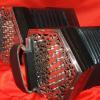
.jpg.4218b20831ebf83d58000af642273628.jpg)

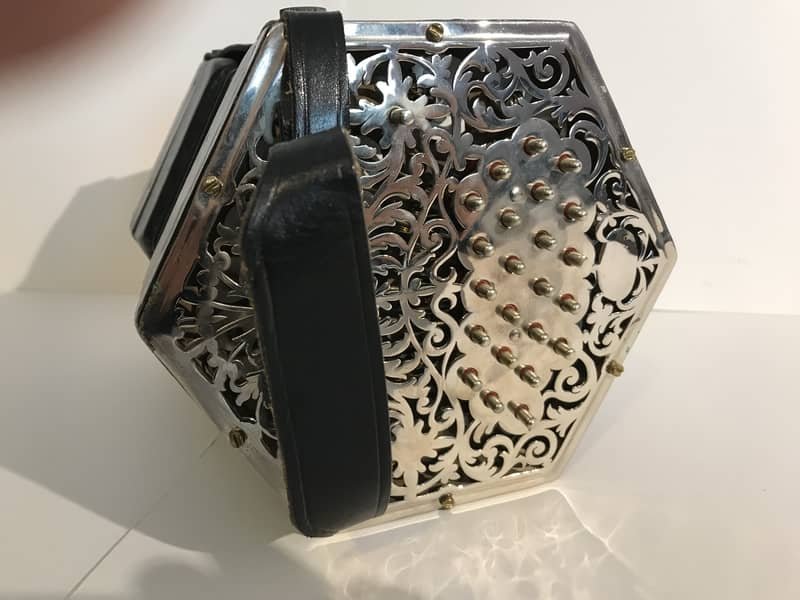
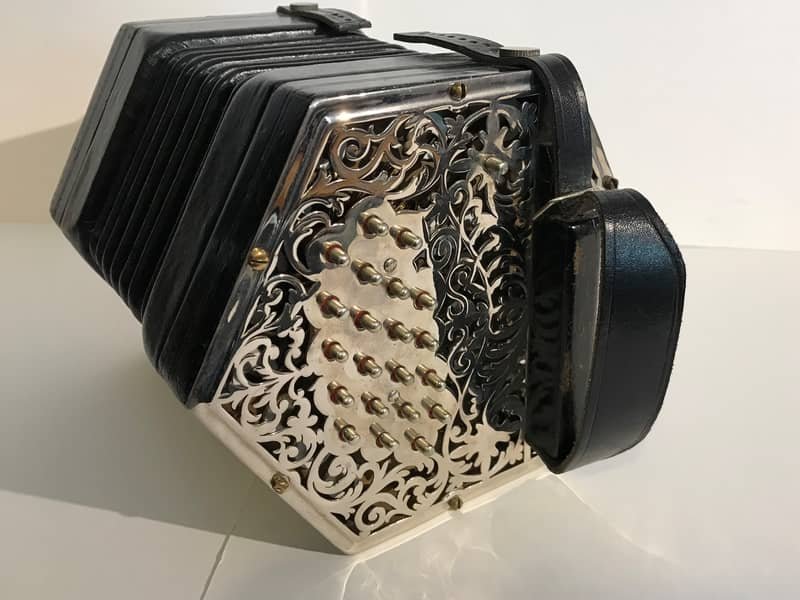

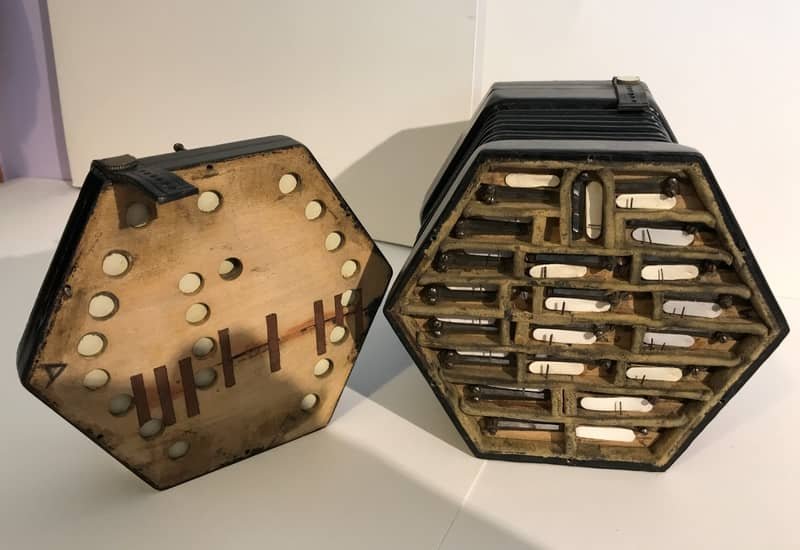




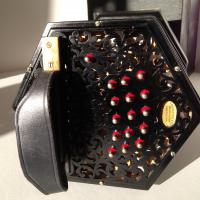
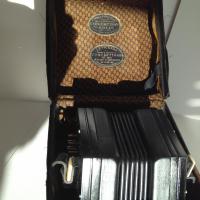
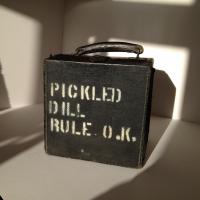
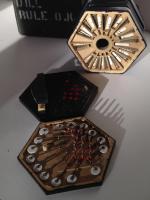
For the specific purpose of sea shanties, does a 20b Anglo Stagi have any advantage over a 30b Anglo Rochelle or Wren?
in General Concertina Discussion
Posted
I fully endorse buying "Sea Songs for 20 button Anglo" Like many Anglo players, I started on a very cheap German 20K box with paper bellows. I found Sea Shanties and "Sea Songs work very well for these, admittedly more limited, instruments. The benefit, of course, is that you can iron out the basics for only a small investment and if you find it's an instrument that suits you, you can then make the requisite, larger investment in a decent machine with far less risk.